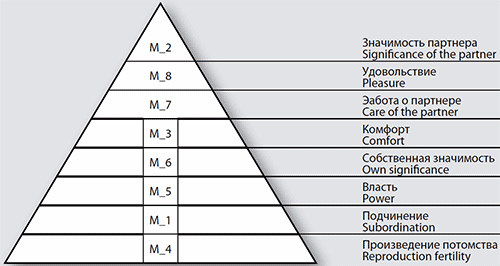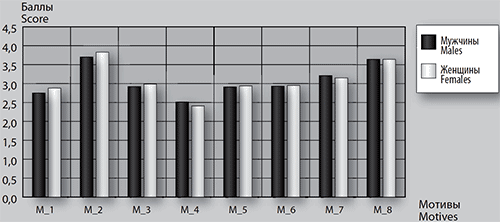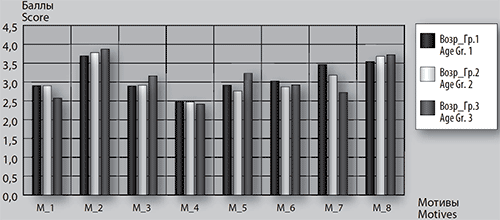Article
Fourmanov I.A. (2017) Dispositional sexual motives as the mirror of values in heterosexual interpersonal relations. National Psychological Journal, 4, 75–82.
Abstract
Background. Values of sexual relations repeatedly changed throughout various culturalhistorical periods. As a result of acquiring values and norms of sexual culture many actual requirements of the personthat were significant at certainontogenetic and sociogeneticstages couldget deprived of the relevance at further stages. As the sociocultural sexual development progresses the subsequent new values, highly significant for the given person are can be shaped. The system of values finds the reflexion in hierarchy and defines dynamics of sexual motives at different stages of the course of life.
Objective. The objective is to define hierarchy, sexual and age distinctions in dispositional sexual motives in early adulthood.
Design. The paper regards the issue of interrelation between sexual motivation and features of gender interpersonal relations. The sexual motivation was considered as interest in a general class of related incentives, all of which provide the same basic type of satisfaction associated with sexual expression. Eight specific types of incentives intrinsic to sexual expression that motivate sexual behaviourare studied: (1) feeling valued by the partner, (2) reinforcing partners value, (3) obtaining relief from stress or negative psychological states, (4) providing care and custody through sexual interaction to improve a partner’s psychological condition, (5) enhancing feelings of personal power, (6) feeling partner’s power, (7) feeling pleasure, and (8) productive fertility.
Conclusion. Disregarding gender and age,the leading position in the hierarchy of sexual disposition motives is occupied by the motives of reinforcing partner’s value, pleasure and care, and subordination position, i.e. motives of comfort, personal value, power and submission. Females in comparison with males differ by higher intensity of submissionmotives and the partner’s significance, while males manifest more force of motive of production fertility. Within the years intensity of motives of partner’s significance, comfort, power and pleasure tends to increase, whereas the motives of submission, personal value and care tend to decrease. The motive of reproduction fertility does not change during years.
Trends of al sexual disposition motivation in males and females at different stages of the early adulthood are designated.
Accepted: 10/30/2017
Pages: 75-82
DOI: 10.11621/npj.2017.0407
PDF: Download
Keywords: sexual motivation; dispositional sexual motives; value of partners; power; submission; pleasure; nurturance;
Available Online 01.01.2018

Fig. 1. Hierarchy of sexual disposition motives

Fig. 2. Sexual differences in sexual disposition motives

Fig. 3. Age differences in sexual disposition motives
References:
Aron, A., &Aron, E.N. (1991) Love and sexuality. In K. McKinney, S. Sprecher (Eds.), Sexuality in close relationships. Hillsdale, NJ: Erlbaum, 25–48.
Baumeister, R. F., Catanese, K. R., &Vohs, K. D. (2001) Is there a gender difference in strength of sex drive? Theoretical views, conceptual distinctions, and a review of relevant evidence. Personality and Social Psychology Review, 5(3), 242–273. 10.1207/S15327957PSPR0503_5
Beck, J.G., Bozman, A.W., & Qualtrough, T. (1991) The experience of sexual desire: Psychological correlates in a college sample. The Journal of Sex Research, 28, 443–456. 10.1080/00224499109551618
Buss, D.M., Schmitt, D.P. (1993) Sexual strategies theory: An evolutionary perspective on human mating. Psychological Review, 100, 204–232. 10.1037/0033-295X.100.2.204
Carroll, J.L., Volk, K.D., &Hyde, J.S. (1985). Differences between males and females in motives for engaging in sexual intercourse. Archives of Sexual Behavior, 14 (2), 131–139. 10.1007/BF01541658
Cooper, M. L., Shapiro, C. M., &Powers, A. M. (1998). Motivations for risky sexual behavior among adolescents and young adults: A functional perspective. Journal of Personality and Social Psychology, 75(6), 1528–1558. 10.1037/0022-3514.75.6.1528
Dawson, D.A. (1990). Trends in use of oral contraceptives: Data from the 1987 National Health Interview Survey. Family Planning Perspectives, 22, 169–172. 10.2307/2135608
Denney, N.W, Field, J.K., & Quadagno, D. (1984). Sex differences in sexual needs and desires. Archives of Sexual Behavior, 13, 233–245. 10.1007/ BF01541650
Fourmanov, I.A. (2016) Polovyie i vozrastnyierazlichiyaseksualnoymotivatsii v period ranneyvzroslosti. [Psikhologicheskoezdorove v konteksterazvitiyalichnosti. Materilay VII Respublikanskoy nauchno-prakticheskoy Konferentsii]. Brest, BRGU, 22–25.
Freud, S. (1990) Tri ocherkapoteoriiseksualnosti. [Psikhologiya bessoznatelnogo]. Moscow, Prosveschenie, 123–201.
Gorman, P. (2002) Motivation and emotion. Routledge modular psychology series, 127. Retrieved from: http://www.eBookstore.tandf.co.uk
Hatfield, E., Luckhurst, C.L., &Rapson, R.L. (2010) Sexual motives: Cultural, evolutionary, and social psychological perspectives. Sexuality and Culture, 14, 173–190. 10.1007/s12119-010-9072-z
Hatfield, E., Luckhurst, C.L., &Rapson, R.L. (2011) Sexual Motives: The Impact of Gender, Personality, and Social Context on Sexual Motives and Sexual Behavior – Especially Risky Sexual Behavior. An International Journal on Personal Relationships, 5 (2), 95–133. 10.5964/ijpr.v5i2.60
Hekhauzen, H. (2003) Motivatsiya i deyatelnost’. 2nd ed. SPb. Piter, Moscow, Smysl, 860.
Hill, C.A. (2002) Gender, Relationship Stage, and Sexual Behavior: The Importance of Partner Emotional Investment Within Specific Situations. The Journal of Sex Research, 39(3), 228–240. 10.1080/00224490209552145
Hill, C.A., Preston, L.K. (1996) Individual differences in the experience of sexual motivation: Theory and measurement of dispositional sexual motives. The Journal of Sex Research, 33, 27–45. 10.1080/00224499609551812
Hull, C. (1943). Principles of Behavior: An Introduction to Behavior Theory. Oxford, England: Appleton-Century-Crofts, 422.
Jonason, P.K., & Fisher, T.D. (2009) The power of prestige: Why young men report having more sex partners than young women. Sex Roles, 60, 151–159. 10.1007/s11199-008-9506-3
Kaschenko, E.A., & Agarkov, S.T. (2015) Seksualnost v tsivilizatsii: sotsiogenez seksualnosti. Moscow, Izdatelski eresheniya, 600.
Kelley, H.H., &Thibaut, J.W. (1978) Interpersonal relations: A theory of interdependence. New York: Wiley, 352.
Kinsey, A.C., Pomeroy, W.B. & Martin, C.E. (1948) Sexual behavior in the human male. Philadelphia, W.B. Saunders, 804.
Leigh, B.C. (1989) Reasons for having and avoiding sex: Gender, sexual orientation, and relationship to sexual behavior. The Journal of Sex Research, 26, 199–209. 10.1080/00224498909551506
Masters, W H., Johnson, V. E. (1966). Human sexual response. Boston: Little & Brown, 366.
Murray, H.A. (1938) Explorations in personality: A clinical and experimental study of fifty men of college age. New York, Oxford University Press, 761.
Rosen, R.C., & Beck, J.G. (1988) Patterns of sexual arousal: Psychophysiological processes and clinical applications. New York, Guilford, 404.
Rusbult, C.E., Martz, J.M., & Agnew C.R. (1998) The Investment Model Scale: Measuring commitment level, satisfaction level, quality of alternatives, and investment size. Personal Relationships, 5 357–391. 10.1111/j.1475-6811.1998.tb00177.x
Rusbult, С.E., Martz, J.J., & Agnew, C.R. (1998) The Investment Model Scale: Measuring commitment level, satisfaction level, quality of alternatives, and investment size. Personal Relationships, 5, 357–391. 10.1111/j.1475-6811.1998.tb00177.x
Schachner, D.A., &S haver P.R. (2004) Attachment dimensions and sexual motives. Personal Relationships, 11, 179–195. 10.1111/j.1475- 6811.2004.00077.x
Schwabish, R.M. (1990) Power and intimacy motives of males in same-sex and opposite-sex dating couples. Unpublished doctoral dissertation, Hofstra University, Hempstead, NY.
Stewart, A.J., & Rubin, Z. (1974) The power motive in the dating couple. Journal of Personality and Social Psychology, 34, 305–309. 0.1037/0022- 3514.34.2.305
Whitley, B.E. (1988). The relation of gender-role orientation to sexual experience among college students. Sex Roles, 19, 619–638. 10.1007/BF00289740
For citing this article:
Fourmanov I.A. (2017) Dispositional sexual motives as the mirror of values in heterosexual interpersonal relations. National Psychological Journal, 4, 75–82.


